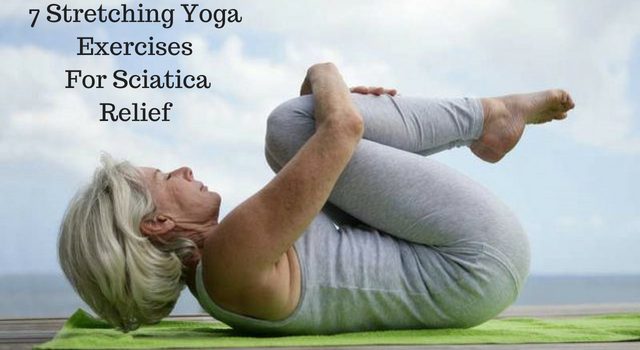7 Stretching Yoga Exercises For Sciatica Relief
Disclosure: As an Amazon Associate I earn from qualifying purchases. This page may contain affiliate links, which means I may receive a commission if you click a link and purchase something that I have recommended. There is never an additional cost to you.
What is Sciatica?
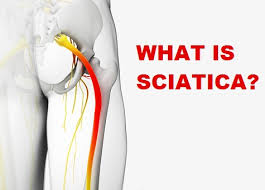
Sciatica describes the feeling of pain or numbness that originates in the lower back, runs through the buttocks, then down the back of the leg via the sciatic nerve.
What Causes Sciatica?
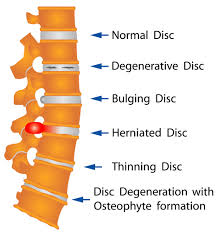
It’s not a medical condition in itself but rather the symptom of some underlying medical condition such as:
- Degenerative Disc Disease – normally occurs with ageing, inflammation and lack of motion around disc
- Herniated Disc in the Lumbar area of the lower back – bulging or leaking disc located between the vertebrae
- Spondylolisthesis – where the vertebrae bone presses on the nerves
- Spinal Stenosis – narrowing of the spine around the spinal cord, typically caused by bone spurs from Osteoporosis
- Piriformis Syndrome – Irritation of the Sciatic nerve by the Piriformis, which is the muscle that runs down the back of the leg
What Are The Symptoms Of Sciatica?
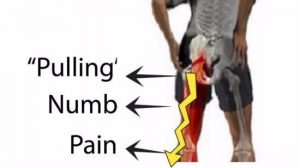
- Pain that runs through only one buttock and down the back of one leg
- Pain that worsens when standing or sitting, but feels better when patients lie down or walk
- A sharp or searing pain rather than a dull one
- Leg or foot weakness or numbness
- Lower back pain, probably not as severe as the leg pain
- Severe pain when standing, or sneezing or coughing, indeed, any sudden movement
How Long Does Sciatica Last?

Two types of Sciatica and how long they might last
- Acute – Usually around 4-6 weeks
- Chronic – Can last several months and might return at some stage. Sometimes requiring surgery in severe cases
How To Cure Sciatica?
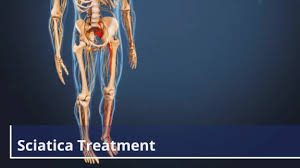
The treatment for Sciatica are as follows
- Heat/Ice packs – applied for 20 mins every 2-3 hours helps alleviate pain
- Pain Medications – Over the counter drugs such as Ibuprofen or Naproxen and sometimes muscle relaxants.
- Epidural Steroid Injections – these are injected straight into the painful area (tends to be temporary relief)
- Chiropracture – manual manipulation and spinal adjustments carried out by a health professional
- Acupunture – Hair thin needles (not painful) are inserted into nerve sites around the pain
- Sciatica Massage Therapy – where the increased blood and stimulated muscles help relieve the pain
- Cognitive Behaviour Therapy – all about taking back control, pain management and taking to a therapist to help relieve the pain
- Stretching, strengthening and mild aerobics exercises – designed to target muscles that are over tight and painful
- Surgery – In severe cases when all other options have been exhausted
How Does Yoga Help With Stretching Exercises For Sciatica?
This depends on the source of the Sciatica. If the Sciatica is caused by a herniated or bulging disc,
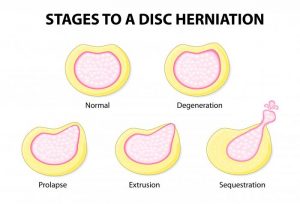
then the gentle poses of downward facing dog or standing poses will align, stretch and strengthen your lower back. This will be greatly aid with not only the current Sciatica problems but also help prevent future problems.
If the source is the Piriformis,
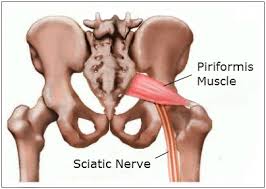
you should focus on yoga exercises that stretch this muscle, but in a gentle and progressive manner, as any excessive straining could cause very severe muscle spasms indeed. Try the Eagle & Cat Cow Poses to start with and then progress to others.
What Yoga Poses Are Best For Sciatica?
Lots of yoga poses will help in some form or another but we believe these are the best yoga exercises for Sciatica relief. Each one should be gentle and progressive rather than excessively strenuous, with much concentration on breathing and holding the pose.
1. The Cobra Pose (Bhujangasana)
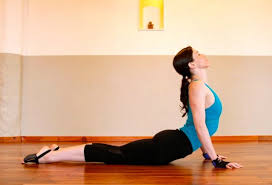
An ideal exercise for Sciatica has it lengthens the lower spine while strengthening the lower spine and glutes
How to do it-
- Lie face down on your mat with your feet hip width apart.
- Place your palms next to your rib cage, keep your elbows tucked tightly to your sides and your public bone pressed into the floor.
- On an inhale press your palms into the mat and slowly lift your chest and upper belly off the ground.
- Roll your shoulders back. Elongate the neck, ensuring your ears are lifted away from your shoulders.
- Inhale slowly for 5 seconds. Hold. Exhale for 5 seconds. Slowly release your self back onto the mat.
2. Standing Hamstring Stretches
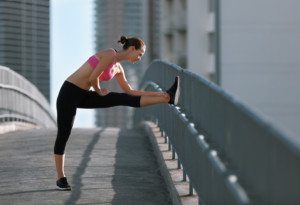
Hamstring stretches can be a major help to relieving Sciatic pain by loosening the tension in the Piriformis. This may have been pressing on the Sciatic nerve and this exercise has sometimes been known to reduce the pain and sometimes to cure the problem altogether.
How to do it-
- If you can, raise your right foot on a support such as a chair, a table, or a bench. Your foot should be at or below hip level, with your leg straight, your knee and toes pointing straight up, and your quadriceps engaged.
- Protect your knee with a microbend if it tends to lock or hyperextend.
- Try to ensure the hip of your raised leg is not lifted, but rather is releasing downward (without the leg or foot turning outward).
- Repeat on each side, holding each one for several breaths.
- For a More deeper stretch, bend forward over your leg at the hip, with your spine and leg straight and your quadriceps firm.
3. Walking Backwards
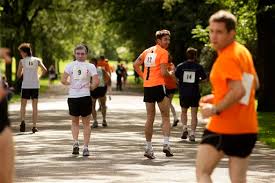
OK, not strictly a yoga pose I know, but I have seen people with Sciatica get immediate relief from this alone, so try it, what have you got to lose, nothing! Walking backwards stretches the hip flexors and helps the low back move into a more natural position. This in turn releases pressure on the Sciatic nerve. This exercise also improves your balance and keeps your mind focussed!
How to do it-
- Find an open space. Check there are no obstacles behind you.
- Walk backwards for 100 yards or more, checking every now and then to ensure path is clear.
4. Downward Facing Dog (Adho Mukha Svanasana)

This helps by stretching the muscles in the hamstring and lower back, releasing pressure on the Sciatic nerve in the process.
How to do it-
- Stand on four limbs, such that your body forms a table-like structure.
- Exhale and gently lift your hips and straighten your elbows and knees. You need to ensure your body forms an inverted ‘V’.
- Your hands should be in line with your shoulders, and your feet in line with your hips. Make sure that your toes point outwards.
- Now, press your hands into the ground and lengthen your neck. Your ears should touch your inner arms, and you should turn your gaze to your navel.
- Hold for a few seconds, and then, bend your knees and return to the table position.
5. Knees To Chest Pose (apanasana)
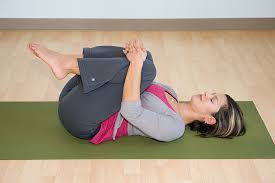
Relieves and warms up the muscles of the lower back, thereby releasing pressure on the sciatic nerve.
How to do it-
- Lie down on your back.
- Check you are relaxed and symmetrical. Support the head with a blanket or pillow if preferred.
- Tune into the natural breath moving in and out of the nostrils. Breathe freely and naturally.
- With your knees and feet hip-width apart, use the hands to gently bring the knees toward the chest as you breathe in. (Hands can either hold the knees, or the back of the thighs, whichever feels right.)
- Keep your head and shoulders resting comfortably on the floor. Draw the knees in only as far as is comfortable, while keeping the shoulders relaxed, broad and grounded.
- When you are ready to exhale, straighten the arms as you guide the knees away from you.
- Repeat 3-5 rounds, moving with the breath; Breathe in, knees away, breathe out, knees in toward the belly.
- When you are ready to come out of apanasana, roll out to the side, press yourself up to a seated position, and observe how you feel.
6. The Eagle Pose (Garudasana)
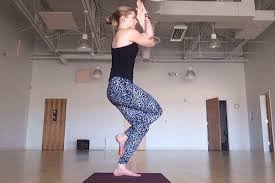
This is more for when your source of Sciatic pain is the Piriformis (the muscle deep in the buttocks behind the gluteus maximus) Again, these poses should be carried out with gentle persuasion rather than sudden jerking movements. This pose is known to be very therapeutic for those with lower back pain and sciatica. Because it opens the back lungs, it also increases breathing capacity and is invigorating for those with asthma. The dynamic balancing aspect of the pose helps to protect your knees against future injury, as well.
Hot to do it-
- Begin standing with your arms at your sides.
- Bend your knees. Balance on your right foot and cross your left thigh over your right. Fix your gaze at a point in front of you. Hook the top of your left foot behind your right calf. Balance for one breath. (Beginners can omit the foot hook and cross the leg over the top of the standing leg, instead, resting the toes gently on the floor).
- Extend your arms straight in front of your body. Drop your left arm under your right.
- Bend your elbows, and then raise your forearms perpendicular to the floor. Wrap your arms and hands, and press your palms together (or as close as you can get them). Lift your elbows and reach your fingertips toward the ceiling. Keep your shoulder blades pressing down your back, toward your waist. (If your palms don’t touch yet, press the backs of your hands together, instead, or hold onto a strap).
- Draw your belly in and up and square your hips and chest to the front wall. .
- Gaze at the tips of your thumbs. Breathe smoothly and evenly.
- Hold for up to one minute, focusing on your breath and keeping your gaze fixed and soft. Gently unwind your arms and legs and return to neutral. Repeat on the opposite side.
7. Cat Cow Pose (Marjaryasana/Bitilasana)

Again, mainly for when the source of Sciatica is the Piriformis, this stretch exercises all sections of the back by strengthening, stretching and releasing tension in the spine. Your slow breathing helps reduce pain and prevent further injuries.
How to do it-
- Bring your hands and knees to the floor.
- Make sure your knees are in line with your hips, and that your wrists are in line with your shoulders and your back and head are centered.
- On an inhale slowly drop your belly towards the floor as you lift your hips, roll your shoulders back and raise your chin towards the sky.
- On an exhale, press your palms firmly into the mat as you curve your spine, rounding the shoulders and tucking the tailbone in.
Sciatica Yoga Poses To Avoid
1. Leg Circles
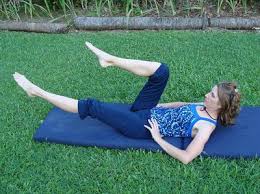
This exercise will pull your hamstring too suddenly, bringing severe pain from your sciatic nerve.
2. Any Sudden Movement Pose or Exercise
Any sudden movement exercise should be avoided as well as jogging until the cause of your Sciatica has been found and possible treatment discussed.
